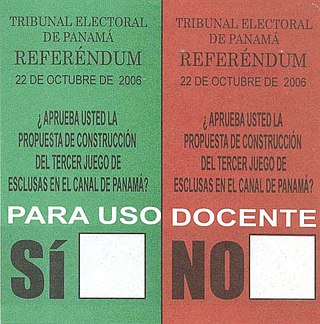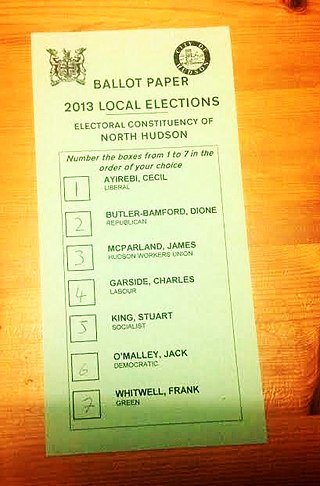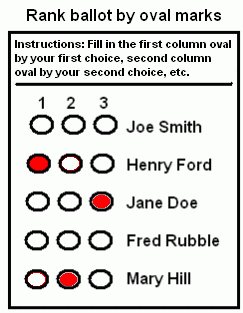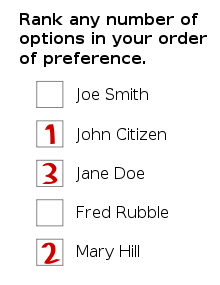
The single transferable vote (STV), sometimes known as proportional ranked choice voting (P-RCV), is a multi-winner electoral system in which each voter casts a single vote in the form of a ranked-choice ballot. Voters have the option to rank candidates, and their vote may be transferred according to alternate preferences if their preferred candidate is eliminated or elected with surplus votes, so that their vote is used to elect someone they prefer over others in the running. STV aims to approach proportional representation based on votes cast in the district where it is used, so that each vote is worth about the same as another. Formally, STV satisfies a fairness criterion known as proportionality for solid coalitions.

Voting is a method by which a group, such as a meeting or an electorate, convenes together for the purpose of making a collective decision or expressing an opinion usually following discussions, debates or election campaigns. Democracies elect holders of high office by voting. Residents of a jurisdiction represented by an elected official are called "constituents", and the constituents who choose to cast a ballot for their chosen candidate are called "voters." There are different systems for collecting votes, but while many of the systems used in decision-making can also be used as electoral systems, any which cater to proportional representation can only be used in elections.
The Droop quota is the quota most commonly used in elections held under the single transferable vote (STV) system. It is also sometimes used in elections held under the largest remainder method of party-list proportional representation. Any candidate that receives quota is declared elected. Under some STV systems, especially those of the full-preferential voting variant, all the winners receive the quota, but in others, of the optional-preferential voting or semi-optional preferential voting variants, it is common for as many as three winners in a district to be elected with less than quota.
The electoral system of Australia comprises the laws and processes used for the election of members of the Australian Parliament and is governed primarily by the Commonwealth Electoral Act 1918. The system presently has a number of distinctive features including compulsory enrolment; compulsory voting; majority-preferential instant-runoff voting in single-member seats to elect the lower house, the House of Representatives; and the use of the single transferable vote proportional representation system to elect the upper house, the Senate.
Electoral systems of the Australian states and territories are broadly similar to the electoral system used in federal elections in Australia.

In electoral systems which use ranked voting, a donkey vote is a cast ballot where the voter ranks the candidates based on the order they appear on the ballot itself. The voter that votes in this manner is referred to as a donkey voter.
A group voting ticket (GVT) is a shortcut for voters in a preferential voting system, where a voter can indicate support for a list of candidates instead of marking preferences for individual candidates. For multi-member electoral divisions with single transferable voting, a group or party registers a GVT before an election with the electoral commission. When a voter selects a group or party above the line on a ballot paper, their vote is distributed according to the registered GVT for that group.
BC-STV is the proposed voting system recommended by the Citizens' Assembly on Electoral Reform in October 2004 for use in British Columbia, and belongs to the single transferable vote family of voting systems. BC-STV was supported by a majority of the voters in a referendum held in 2005 but the government had legislated that it would not be bound by any vote lower than 60 percent in favour. Because of the strong majority support for BC-STV, the government elected to stage a second referendum in 2009, but with increased public funding for information campaigns to better inform the electorate about the differences between the existing and proposed systems. The leadership of both the "yes" side and the "no" side were assigned by the government. The proposal was rejected with 60.9 percent voting against, vs. 39.1 percent in favour, in the 2009 vote.
The single transferable vote (STV) is a proportional representation voting system that elects multiple winners. It is one of several ways of choosing winners from ballots that rank candidates by preference. Under STV, an elector's vote is initially allocated to their most-preferred candidate. Candidates are elected (winners) if their vote tally reaches quota. After this 1st Count, if seats still remain open, surplus votes are transferred from winners to remaining candidates (hopefuls) according to the surplus ballots' next usable back-up preference. if no surplus votes have to be transferred, then the least-popular candidate is eliminated so the vote has chance to be placed on a candidate who can use it.
Instant-runoff voting (IRV) is a voting method used in single-seat elections with more than two candidates. Instead of voting only for a single candidate, voters in IRV elections can rank the candidates in order of preference. Ballots are initially counted for each elector's top choice, losing candidates are eliminated, and ballots for losing candidates are redistributed until one candidate is the top remaining choice of a majority of the voters. When the field is reduced to two, it has become an "instant runoff" that allows a comparison of the top two candidates head-to-head.

In voting, a ballot is considered spoilt, spoiled, void, null, informal, invalid or stray if a law declares or an election authority determines that it is invalid and thus not included in the vote count. This may occur accidentally or deliberately. The total number of spoilt votes in a United States election has been called the residual vote. In Australia, such votes are generally referred to as informal votes, and in Canada they are referred to as rejected votes.
The later-no-harm criterion is a voting system criterion formulated by Douglas Woodall. Woodall defined the criterion as "[a]dding a later preference to a ballot should not harm any candidate already listed." For example, a ranked voting method in which a voter adding a 3rd preference could reduce the likelihood of their 1st preference being selected, fails later-no-harm.
A Langer vote was a style of voting in the Australian electoral system designed to avoid the requirement to express preferences for all candidates without the vote being rejected as informal. The title is a tribute to Albert Langer, an Australian political activist, who advocated for the use of this style as a de facto method of optional preferential voting for making a valid vote for the voter's preferred candidates while the deliberate "error" avoided the vote being counted for one of the major political parties.
There are a number of complications and issues surrounding the application and use of single transferable vote proportional representation that form the basis of discussions between its advocates and detractors.

How-to-vote cards (HTV) are small leaflets that are handed out by party supporters during elections in Australia. Voting in the Australian lower house uses a preferential voting system. Voters must rank every candidate on the ballot in order for their vote to count. There are often numerous candidates on the ballot, some with little public profile, so voters may find it difficult to decide on all of them. Parties produce how-to-vote cards ostensibly to help voters. They contain details about the candidate or party as well as instruction how to cast a ranked vote in the order that the party would prefer the voter follow. The flow of preferences can assist the party dispersing the cards directly and indirectly help allied parties.
Preferential block voting is a majoritarian voting system for electing several representatives from a multimember constituency, such as a state. Unlike single transferable voting (STV) or list PR, preferential block voting is not a method for obtaining proportional representation, and instead produces similar results to plurality block voting. Preferential block voting can be seen as a multiple-winner version of instant-runoff, a multiple transferable vote (MTV).

The Wright system is a refinement of rules associated with proportional representation by means of the single transferable vote (PR-STV) electoral system. It was developed and written by Anthony van der Craats, a system analyst and life member of the Proportional Representation Society of Australia. It is described in a submission into a parliamentary review of the 2007 Australian federal election.
Instant-runoff voting (IRV) is an electoral system that uses ranked voting. Its purpose is to elect the majority choice in single-member districts in which there are more than two candidates and thus help ensure majority rule. It is a single-winner version of single transferable voting. Formerly the term "instant-runoff voting" was used for what many people now call contingent voting or supplementary vote.

The term ranked voting, also known as preferential voting or ranked choice voting, pertains to any voting system where voters use a rank to order candidates or options—in a sequence from first, second, third, and onwards—on their ballots. Ranked voting systems vary based on the ballot marking process, how preferences are tabulated and counted, the number of seats available for election, and whether voters are allowed to rank candidates equally. An electoral system that utilizes ranked voting employs one of numerous counting methods to determine the winning candidate or candidates. Additionally, in some ranked voting systems, officials mandate voters to rank a specific number of candidates, sometimes all; while in others, voters may rank as many candidates as they desire.
The spare vote is a version of single transferable voting applied to the ranking of parties, first proposed for elections in Germany in 2013. This preferential party system is a ranked proportional representation electoral system applying to political parties instead of individual candidates. The spare vote refers to a secondary vote (preference) of the voter, which only comes into play if the first preference for the political party preferred by the voter, is below the electoral threshold. In Germany, there were draft laws for the spare vote system in Saarland, Schleswig-Holstein and Brandenburg federal states, but they were not implemented.







